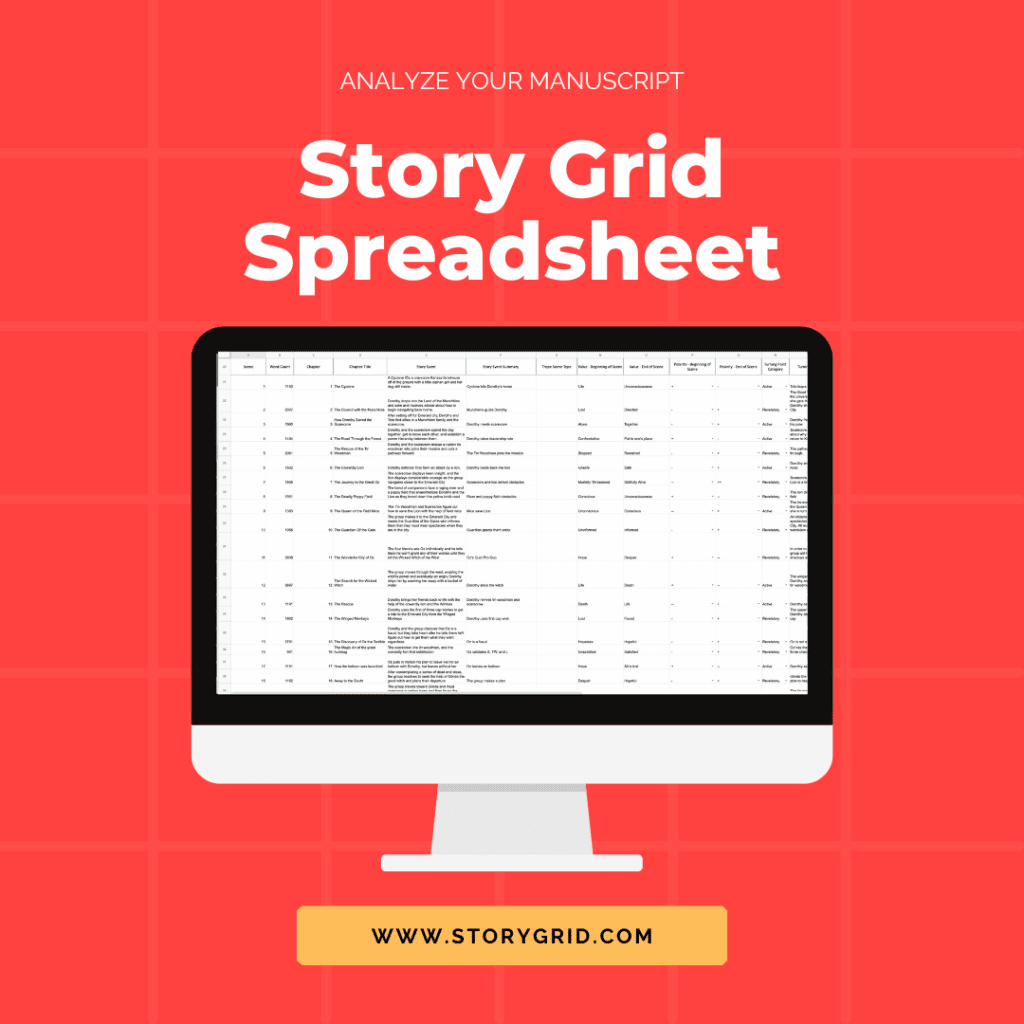What is the Story Grid Spreadsheet?
The Story Grid Spreadsheet is a tool writers and editors use to analyze scenes across an entire story. The spreadsheet helps us to improve our scenes and stories by diagnosing problems in our own works in progress. We also apply this tool to the studying MASTERWORKS to see how other writers address the same problems we find in our writing.
Many people revise their stories after drafting, but they do not use tools that will help them objectively determine what’s not working and the steps they can take to improve their stories. They have a gut-level understanding of what happens and when, but the details get lost. They end up revising without a complete and accurate picture of the story. At Story Grid, we use the spreadsheet to track the whole story and its necessary components. Then we can find solutions for problems.

Spreadsheet Structure
The spreadsheet is a global and scene-level tool for diagnosing problems by making concrete notes about a specific unit of story, most often the scene. We can parse out the inner workings of a story to look at it from different angles. This allows us to find solutions when we struggle with our own work and to level up our craft.
Spreadsheet Function
The Story Grid Spreadsheet allows us to track how well we’ve executed our story idea. Because the spreadsheet shows the story in a collapsed, scene-by-scene layout, we can track value shifts and other story elements more easily.
Viewing a story this way helps both writers and editors find patterns within the scenes and to understand the function of every scene within the global story. For example, the spreadsheet will reveal if a scene is not contributing to the global story. Then we can modify or cut it to make the story stronger. This is a horizontal review. When we review the data in each column we can see how we are executing elements, like the VALUE SHIFT, across the entire story. This is a vertical review. Horizontal and vertical reviews allow us to improve the entire fabric of our stories.
Spreadsheet Organization
The Spreadsheet is organized into different sections based on the part of the scene the columns track. (The notations correspond to columns within the Story Grid Spreadsheet template.)
- Identifying the Scene (Columns A-F): In these columns, we track the global story on a scene-by-scene level. We identify where the scene is within the story, the length in words (or minutes for scenes in a film), and what happens in that scene. This ensures we know the specific part of the story we are analyzing.
- Change (Columns N-S): In these columns, we track the quality of the change, the direction of change, and the moment a change in value becomes imminent. This includes the change in value (for example, safe to threatened or unknown to repulsed), polarity shift (for example, + to – or – – to -), and turning point of every scene. We can see clearly whether the scenes are turning, if they are affecting the global value, and how they are turning. Analyzing these columns across many scenes (vertical analysis) allows us to see how SAM (the Single Audience Member) is observing change in each scene and how that change builds to the global VALUE SHIFT.
- Continuity (Columns T-W): With these columns, we ensure that the point of view, period, duration, and location of the scene make sense throughout the story. Through them, we track and analyze the story experience for SAM and the AVATARS (or characters).
- Avatars (Columns X-AA): This section reveals which avatars are onstage during a scene and which ones are simply mentioned. This allows us to monitor SAM’s experience of the avatars in the story. For example, we can check that the amount of time avatars spend onstage correlates to their importance in the story.
- Global Story (Columns AB-AJ): Here the spreadsheet tracks the global story by identifying the FIVE COMMANDMENTS within the QUADRANTS as well as the CONVENTIONS and OBLIGATORY MOMENTS. This enables us to check that we’ve included these essential features throughout the story.
Spreadsheet Examples
You can view the spreadsheet analysis of two masterworks analyzed by Story Grid creator Shawn Coyne. The spreadsheets are located in the second tab, which you can select at the bottom of the sheet. Be sure to check at the FOOLSCAP as well. It condenses the global story elements on a single page.
Pride and Prejudice
Pride and Prejudice Story Grid Spreadsheet
Wonderful Wizard of Oz
The Wonderful Wizard of Oz Story Grid Spreadsheet
The Silence of the Lambs
The Silence of the Lambs Spreadsheet
Additional Spreadsheet Resources:
- Story Grid Spreadsheet Template
- The Story Grid: What Good Editors Know by Shawn Coyne
- Story Grid 101: The Five First Principles of the Story Grid Methodology by Shawn Coyne
- The Story Microscope: The Surprising Way a Spreadsheet Can Save Your Manuscript by Kimberly Kessler